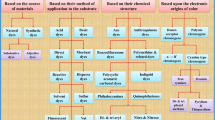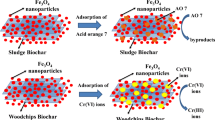Abstract
A novel adsorbent (PN-Fe3O4-IDA-Zr) was developed from the chemical modification of peanut husk (a low cost material) with Fe3O4, iminodiacetic acid (IDA) and zirconium (Zr) and its efficacy for the sequestration of wastewater assessed using Alizarin red (AR) and Acid chrome blue K (AK) as model pollutants. To elucidate the characteristics of the formed adsorbent, analytical techniques such as the Bruauner-Emmet-Teller (BET) method, X-ray photoelectron spectroscopy (XPS), Fourier-transform infrared (FTIR) spectroscopy, X-ray diffractive spectroscopy (XRD) and vibrating sample magnetometer (VSM) were applied. Results from these studies confirmed the formation of a crystalline mesoporous adsorbent with surface properties which enhanced its usefulness. From the adsorption studies, it was observed that factors such as pH, salts, temperature and contact time influenced the uptake of the anionic dyes. The maximum monolayer capacity of PN-Fe3O4-IDA-Zr for AR was 49.4 mg g−1 (at 313 K) and was well fitted by the Langmuir model with the chemisorption process being the dominant reaction mechanism. In binary systems, PN-Fe3O4-IDA-Zr exhibited higher affinity for AR as compared with AK. The significant removal efficiency exhibited by this novel adsorbent as well as other unique features such as easy retrieval and high regeneration promotes its prospects as an adsorbent for practical wastewater remediation processes.
Graphical abstract










Similar content being viewed by others
Availability of data materials
All data generated or analysed during this study are included in this published article
References
Albadarin AB, Mangwandi C (2015) Mechanisms of alizarin red s and methylene blue biosorption onto olive stone by-product: Isotherm study in single and binary systems. J Environ Manag 164:86–93. https://doi.org/10.1016/j.jenvman.2015.08.040
Aryee AA, Mpatani FM, Kani AN, Dovi E, Han RP, Li ZH, Qu LB (2020a) Iminodiacetic acid functionalized magnetic peanut husk for the removal of methylene blue from solution: characterization and equilibrium studies. Environ Sci Pollut Res 27:40316–40330. https://doi.org/10.1007/s11356-020-10087-6
Aryee AA, Mpatani FM, Zhang XT, Kani AN, Dovi E, Han RP, Li ZH, Qu LB (2020b) Iron (III) and iminodiacetic acid functionalized magnetic peanut husk for the removal of phosphate from solution: Characterization, kinetic and equilibrium studies. J Clean Prod 268:122191. https://doi.org/10.1016/j.jclepro.2020.122191
Aryee AA, Zhang RZ, Liu HF, Han RP, Li ZH, Qu LB (2020c) Application of magnetic peanut husk for methylene blue adsorption in batch mode. Desalin Water Treat 194:269–279. https://doi.org/10.5004/dwt.2020.25862
Aryee AA, Mpatani FM, Yangyang D, Kani AN, Dovi E, Han RP, Li ZH, Qu LB (2021) Fe3O4 and iminodiacetic acid modified peanut husk as a novel adsorbent for the uptake of Cu(II) and Pb(II) in aqueous solution: Characterization, equilibrium and kinetic study. Eviron Pollut 268:115729. https://doi.org/10.1016/j.envpol.2020.115729
Bayramoglu G, Arica MY (2020) Modification of epoxy groups of poly(hydroxylmethyl methacrylate-co-glycidyl methacrylate) cryogel with H3PO4 as adsorbent for removal of hazardous pollutants. Environ Sci Pollut Res 27:43340–43358. https://doi.org/10.1007/s11356-020-10170-y
Bayramoglu G, Kunduzcu G, Arica MY (2020) Preparation and characterization of strong cation exchange terpolymer resin as effective adsorbent for removal of disperse dyes. Polym Eng Sci 60(1):192–201. https://doi.org/10.1002/pen.25272
Bhatti HN, Mahmood Z, Kausar A, Yakout SM, Shair OH, Iqbal M (2020) Biocomposites of polypyrrole, polyaniline and sodium alginate with cellulosic biomass: adsorption-desorption, kinetics and thermodynamic studies for the removal of 2,4-dichlorophenol. Int J Biol Macromol 153:146–157. https://doi.org/10.1016/j.ijbiomac.2020.02.306
Crini G, Lichtfouse E (2019) Advantages and disadvantages of techniques used for wastewater treatment. Environ Chem Lett 17:145–155. https://doi.org/10.1007/s10311-018-0785-9
Crini G, Lichtfouse E, Wilson L, Crini NM (2019) Conventional and non-conventional adsorbents for wastewater treatment. Environ Chem Lett 17(1):195–213. https://doi.org/10.1007/s10311-018-0786-8
De Gisi S, Lofrano G, Grassi M, Notarnicola M (2016) Characteristics and adsorption capacities of low-cost sorbents for wastewater treatment: A review. Sustain Mater Technol 9:10–40. https://doi.org/10.1016/j.susmat.2016.06.002
Elimelech M (2006) The global challenge for adequate and safe water. J Water Supply Res T 55:3–10. https://doi.org/10.2166/aqua.2005.064
Fayazi M, Ghanei-Motlagh M, Taher MA (2015) The adsorption of basic dye (Alizarin red S) from aqueous solution onto activated carbon/γ-Fe2O3 nano-composite: kinetic and equilibrium studies. Mater Sci Semicond Process 40:35–43. https://doi.org/10.1016/j.mssp.2015.06.044
Fu F, Gao ZW, Gao LX, Li DS (2011) Effective adsorption of anionic dye, alizarin reds, from aqueous solutions on activated clay modified by iron oxide. Ind Eng Chem Res 50(16):9712–9717. https://doi.org/10.1021/ie200524b
Gu YF, Yang MM, Wang WL, Han RP (2019) Phosphate adsorption from solution by zirconium loaded carbon nanotubes in batch mode. J Chem Eng Data 64(6):2849–2858. https://doi.org/10.1021/acs.jced.9b00214
Han RP, Zou WH, Yu WH, Cheng SS, Wang YF, Shi J (2007) Biosorption of methylene blue from aqueous solution by fallen phoenix tree’s leaves. J Hazard Mater 141(1):156–162. https://doi.org/10.1016/j.jhazmat.2006.06.107
Han RP, Zhang LJ, Song C, Zhang MM, Zhu HM, Zhang LJ (2010) Characterization of modified wheat straw, kinetic and equilibrium study about copper ion and methylene blue adsorption in batch mode. Carbohydr Polym 79(4):1140–1149. https://doi.org/10.1016/j.carbpol.2009.10.054
Hassan MM, Carr CM (2018) A critical review on recent advancements of the removal of reactive dyes from dye house effluent by ion-exchange adsorbents. Chemosphere 209(1):201–219. https://doi.org/10.1016/j.chemosphere.2018.06.043
Hu YY, Han RP (2019) Selective and efficient removal of anionic dyes from solution by zirconium (IV) hydroxide coated magnetic materials. J Chem Eng Data 64(2):791–799. https://doi.org/10.1021/acs.jced.8b01063
Kani AN, Dovi E, Mpatani FM, Li ZH, Han RP, Qu LB (2020) Tiger Nut Residue as a renewable adsorbent for methylene blue removal from solution: Adsorption kinetics, isotherm, and thermodynamic studies. Desalin Water Treat 191:426–437. https://doi.org/10.5004/dwt.2020.25735
Lellis B, Fávaro-Polonio CZ, Pamphile JA, Polonio JC (2019) Effects of textile dyes on health and the environment and bioremediation potential of living organisms. Biotechnol Res Innov 50:1–16. https://doi.org/10.1016/j.biori.2019.09.001
Liu JC, Yu Y, Zhu SY, Yang JK, Song J, Fan W, Yu HB, Bian DJ, Huo MX (2018) Synthesis and characterization of a magnetic adsorbent from negatively-valued iron mud for methylene blue adsorption. PLoS One 13(2):e0191229. https://doi.org/10.1371/journal.pone.0191229
Liu MY, Zhang XT, Li ZH, Qu LB, Han RP (2020) Fabrication of zirconium (IV)-loaded chitosan/Fe3O4/graphene oxide for efficient removal of alizarin red from aqueous solution. Carbohydr Polym 248:116792. https://doi.org/10.1016/j.carbpol.2020.116792
Ma J, Li JY, Guo QH, Han HY, Zhang SS, Han RP (2020) Waste peanut shell modified with polyethyleneimine for enhancement of hexavalent chromium removal from solution in batch and column modes. Bioresour Technol Rep 12:100576. https://doi.org/10.1016/j.biteb.2020.100576
Ma CH, Zhang XT, Wen K, Wang R, Han RP (2021) Facile synthesis of polyethyleneimine@Fe3O4 loaded with zirconium for enhanced phosphate adsorption: Performance and adsorption mechanism. Korean J Chem Eng 38(1):135–143. https://doi.org/10.1007/s11814-020-0663-6
Machado FM, Carmalin SA, Lima EC, Dias SLP, Prola LDT, Saucier C, Fagan SB (2016) Adsorption of alizarin red dye by carbon nanotubes: an experimental and theoretical investigation. J Phys Chem C 120(32):18296–18306. https://doi.org/10.1021/acs.jpcc.6b03884
Mpatani FM, Aryee AA, Kani AN, Guo QH, Dovi E, Qu LB, Li ZH, Han RP (2020a) Uptake of micropollutant-bisphenol A, methylene blue and neutral red onto a novel bagasse-β-cyclodextrin polymer by adsorption process. Chemosphere 259:127439. https://doi.org/10.1016/j.chemosphere.2020.127439
Mpatani FM, Aryee AA, Kani AN, Wen K, Dovi E, Qu LB, Li ZH, Han RP (2020b) Removal of methylene blue from aqueous medium by citrate modified bagasse: Kinetic, Equilibrium and Thermodynamic study. Bioresour Technol Rep 11:100463. https://doi.org/10.1016/j.biteb.2020.100463
Nindiyasari F, Griesshaber E, Zimmermann T, Manian AP, Randow C, Zehbe R, Schmahl WW (2015) Characterization and mechanical properties investigation of the cellulose/gypsum composite. J Compos Mater 50(5):657–672. https://doi.org/10.1177/0021998315580826
Oun A, Tahri N, Mahouche-Chergui S, Carbonnier B, Majumdar S, Sarkar S, Sahoo GC, Ben Amar R (2017) Tubular ultrafiltration ceramic membrane based on titania nanoparticles immobilized on macroporous clay-alumina support: Elaboration, characterization and application to dye removal. Sep Purif Technol 188:126–133. https://doi.org/10.1016/j.seppur.2017.07.005
Prithivirajan R, Jayabal S, Sundaram SK, Sangeetha V (2015) Hybrid biocomposites from agricultural residues: mechanical, water absorption and tribological behaviors. J Polym Eng 36(7):663–672. https://doi.org/10.1515/polyeng-2015-0113
Qin HQ, Hu TJ, Zhai YB, Lu NQ, Aliyeva J (2020) The improved methods of heavy metals removal by biosorbents: a review. Environ Pollut 258:113777. https://doi.org/10.1016/j.envpol.2019.113777
Repo E, Warchoł JK, Bhatnagar A, Mudhoo A, Sillanpää M (2013) Aminopolycarboxylic acid functionalized adsorbents for heavy metals removal from water. Water Res 47(14):4812–4832. https://doi.org/10.1016/j.watres.2013.06.020
Sharma S, Bhattacharya A (2016) Drinking water contamination and treatment techniques. Appl Water Sci 7(3):1043–1067. https://doi.org/10.1007/s13201-016-0455-7
Shertate RS, Thorat P (2014) Biotransformation of textile dyes: a bioremedial aspect of marine environment. Am J Environ Sci 10(5):489–499. https://doi.org/10.3844/ajessp.2014.489.499
Silva VAJ, Andrade PL, Silva MPC, Bustamante DA, De Los Santos Valladares L, Albino Aguiar J (2013) Synthesis and characterization of Fe3O4 nanoparticles coated with fucan polysaccharides. J Magn Magn Mater 343:138–143. https://doi.org/10.1016/j.jmmm.2013.04.062
Tan TL, Krusnamurthy PA, Nakajima H, Rashid SA (2020) Adsorptive, kinetics and regeneration studies of fluoride removal from water using zirconium-based metal organic frameworks. RSC Adv 10(32):18740–18752. https://doi.org/10.1039/D0RA01268H
Wu YJ, Zhang LJ, Gao CL, Ma JY, Ma XH, Han RP (2009) Adsorption of copper ions and methylene blue in single and binary system on wheat straw. J Chem Eng Data 54(12): 3229–3234. https://doi.org/10.1021/je900220q
Yang JY, Jiang XY, Jiao FP, Yu JG (2018) The oxygen-rich pentaerythritol modified multi-walled carbon nanotube as an efficient adsorbent for aqueous removal of alizarin yellow R and alizarin red S. Appl Surf Sci 436:198–206. https://doi.org/10.1016/j.apsusc.2017.12.029
Xu X, Gao BY, Jin B, Yue QY (2016) Removal of anionic pollutants from liquids by biomass materials: A review. J Mol Liq 215:565–595. https://doi.org/10.1016/j.molliq.2015.12.101
Zhang RD, Zhang JH, Zhang XN, Dou CC, Han RP (2014) Adsorption of congo red from aqueous solutions using cationic surfactant modified wheat straw in batch mode: Kinetic and equilibrium study. J Taiwan Inst Chem E 45(5):2578–2583. https://doi.org/10.1016/j.jtice.2014.06.009
Zhang XL, Qian JS, Pan BC (2016) Fabrication of novel magnetic nanoparticles of multifunctionality for water decontamination. Environ Sci Technol 50(2):881–889. https://doi.org/10.1021/acs.est.5b04539
Zhang Z, Chen H, Wu W, Pang W, Yan G (2019) Efficient removal of Alizarin Red S from aqueous solution by polyethyleneimine functionalized magnetic carbon nanotubes. Bioresour Technol 293:122100. https://doi.org/10.1016/j.biortech.2019.122100
Zhang XT, Ma CH, Wen K, Han RP (2020) Adsorption of phosphate from solution by lanthanum modified macroporous chelating resin. Korean J Chem Eng 37(5):776–775. https://doi.org/10.1007/s11814-020-0495-4
Zhao YS, Qu F, Wan ZJ, Zhang Y, Weiguo Liang WG, Meng QR (2010) Experimental investigation on correlation between permeability variation and pore structure during coal pyrolysis. Transp Porous Media 82:401–412. https://doi.org/10.1007/s11242-009-9436-8
Zhao BL, Xiao W, Shang Y, Zhu HM, Han RP (2014) Adsorption of light green anionic dye using cationic surfactant-modified peanut husk in batch mode. Arab J Chem 10:S3595–S3602. https://doi.org/10.1016/j.arabjc.2014.03.010
Zhou T, Lu WZ, Liu LF, Zhu HM, Jiao YB, Zhang SS, Han RP (2015) Effective adsorption of light green anionic dye from solution by CPB modified peanut in column mode. J Mol Liq 211:909–914. https://doi.org/10.1016/j.molliq.2015.08.018
Acknowledgement
This work was supported by National Natural Science Foundation of China (21974125), the Key Scientific Research Project in Universities of Henan Province (19A150048), and the Foundation for University Key Teacher by Henan Province (2017GGJS007).
Author information
Authors and Affiliations
Contributions
Aaron Albert Aryee (a.niiayi@yahoo.com)—conceptualization, methodology, formal analysis, investigation, visualization, data curation, writing (original draft)
Evans Dovi (evansdovy@gmail.com)—formal analysis
Qiehui Guo (2375527130@qq.com)—investigation
Mingyu Liu (lmylittlerain@163.com)—methodology
Han Runping (rphan67@zzu.edu.cn)—conceptualization, visualization, fata curation, supervision, funding acquisition
Zhaohui Li (zhaohui.li@zzu.edu.cn)—supervision, funding acquisition
Lingbo Qu (qulingbo@zzu.edu.cn)—funding acquisition
Corresponding authors
Ethics declarations
Ethical approval
Not Applicable
Consent to participate
Not Applicable
Consent to publish
Not Applicable
Competing interest
The authors declare that they have no competing interests
Additional information
Responsible editor: Tito Roberto Cadaval Jr
Publisher’s note
Springer Nature remains neutral with regard to jurisdictional claims in published maps and institutional affiliations.
Highlights
➢ Zirconium and Iminodiacetic acid modified magnetic peanut husk was synthesized.
➢ PN-Fe3O4-IDA-Zr was found to be crystalline and mesoporous with unique surface properties.
➢ PN-Fe3O4-IDA-Zr exhibits enhanced removal efficiency for anionic dyes with selectivity.
➢ The chemisorption process was the main underlying mechanism.
➢ There was high reusability after regeneration with 0.1 mol L−1 NaOH.
Rights and permissions
About this article
Cite this article
Aryee, A.A., Dovi, E., Guo, Q. et al. Selective removal of anionic dyes in single and binary system using Zirconium and iminodiacetic acid modified magnetic peanut husk. Environ Sci Pollut Res 28, 37322–37337 (2021). https://doi.org/10.1007/s11356-021-13030-5
Received:
Accepted:
Published:
Issue Date:
DOI: https://doi.org/10.1007/s11356-021-13030-5




